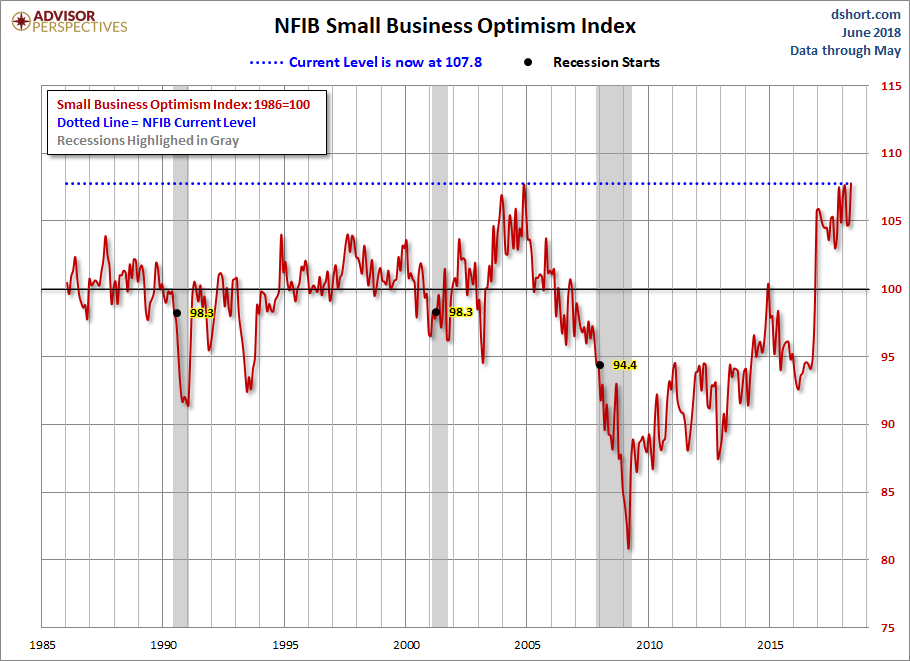The latest issue of the NFIB Small Business Economic Trends came out this morning. The headline number for May came in at 107.8, up 3.0 from the previous month. The index is at the 100th percentile in this series. Today's number came in above the Investing.com forecast of 105.2.
Here is an excerpt from the opening summary of the news release.
The Small Business Optimism Index increased in May to the second highest level in the NFIB survey’s 45-year history. The index rose to 107.8, a three-point gain, with small businesses reporting high numbers in several key areas including compensation, profits, and sales trends.
“Main Street optimism is on a stratospheric trajectory thanks to recent tax cuts and regulatory changes. For years, owners have continuously signaled that when taxes and regulations ease, earnings and employee compensation increase,” said NFIB President and CEO Juanita Duggan.
The first chart below highlights the 1986 baseline level of 100 and includes some labels to help us visualize that dramatic change in small-business sentiment that accompanied the Great Financial Crisis. Compare, for example, the relative resilience of the index during the 2000-2003 collapse of the Tech Bubble with the far weaker readings following the Great Recession that ended in June 2009.
Here is a closer look at the indicator since the turn of the century. We are just below the post-recession high.
The average monthly change in this indicator is 3.0 points. To smooth out the noise of volatility, here is a 3-month moving average of the Optimism Index along with the monthly values, shown as dots.
Here are some excerpts from the report.
Labor Markets
Reports of employment gains remain strong among small businesses. Owners reported adding a net 0.20 workers per firm on average, slower than earlier in the year but strong.
Inflation
How effective has the Fed's monetary policy been in lifting inflation to it two percent target rate?
The net percent of owners raising average selling prices rose 5 points to a net 19 percent seasonally adjusted, resuming a march to higher average selling prices that started in the fourth quarter of 2016. The Federal Reserve’s target of 2 percent inflation (based on the headline PCE price deflator) has not been reached, but it is close.
Credit Markets
Has the Fed's zero interest rate policy and quantitative easing had a positive impact on Small Businesses?
Four percent of owners reported that all their borrowing needs were not satisfied, unchanged and historically low. Thirty-seven percent reported all credit needs met (up 5 points) and 43 percent said they were not interested in a loan, down 7 points and the lowest reading since April 2007.
NFIB Commentary
This month's "Commentary" section includes the following observations and opinions:
A vibrant democracy depends on a strong, free, private sector. The Administration and Congress have implemented important policy changes that strengthen the private sector. The new tax code is returning money to the private sector where history makes clear it will be better invested than by a government bureaucracy. Regulatory costs, as significant as taxes, are being reduced.
Business Optimism and Consumer Confidence
The next chart is an overlay of the Business Optimism Index and the Conference Board Consumer Confidence Index. The consumer measure is the more volatile of the two, so it is plotted on a separate axis to give a better comparison of the two series from the common baseline of 100.
These two measures of mood have been highly correlated since the early days of the Great Recession. The two diverged after their previous interim peaks, but have recently resumed their correlation. A decline in Small Business Sentiment was a long leading indicator for the last two recessions.










